Report on Developing Manager: Leadership, Skills & Hotel Analysis
VerifiedAdded on 2024/06/13
|24
|4147
|377
Report
AI Summary
This report examines the concept of a 'developing manager' through the lens of personal and professional development, applying management and leadership theories to practical examples in the hotel industry, specifically The William Vale and The Wythe. It compares various management approaches, including classical, chaos, and contingency theories, and contrasts leadership styles such as autocratic, democratic, laissez-faire, and charismatic. The report also analyzes communication methods within the hotels, highlighting the importance of effective communication. Furthermore, it delves into organizational culture, structure, and change management, referencing the planned change theory. The report includes a personal management skill assessment, a SWOT analysis, and identifies priorities and targets for personal development in the context of a potential management role at Clayton Crown Hotel London, emphasizing the importance of continuous improvement and skill enhancement.
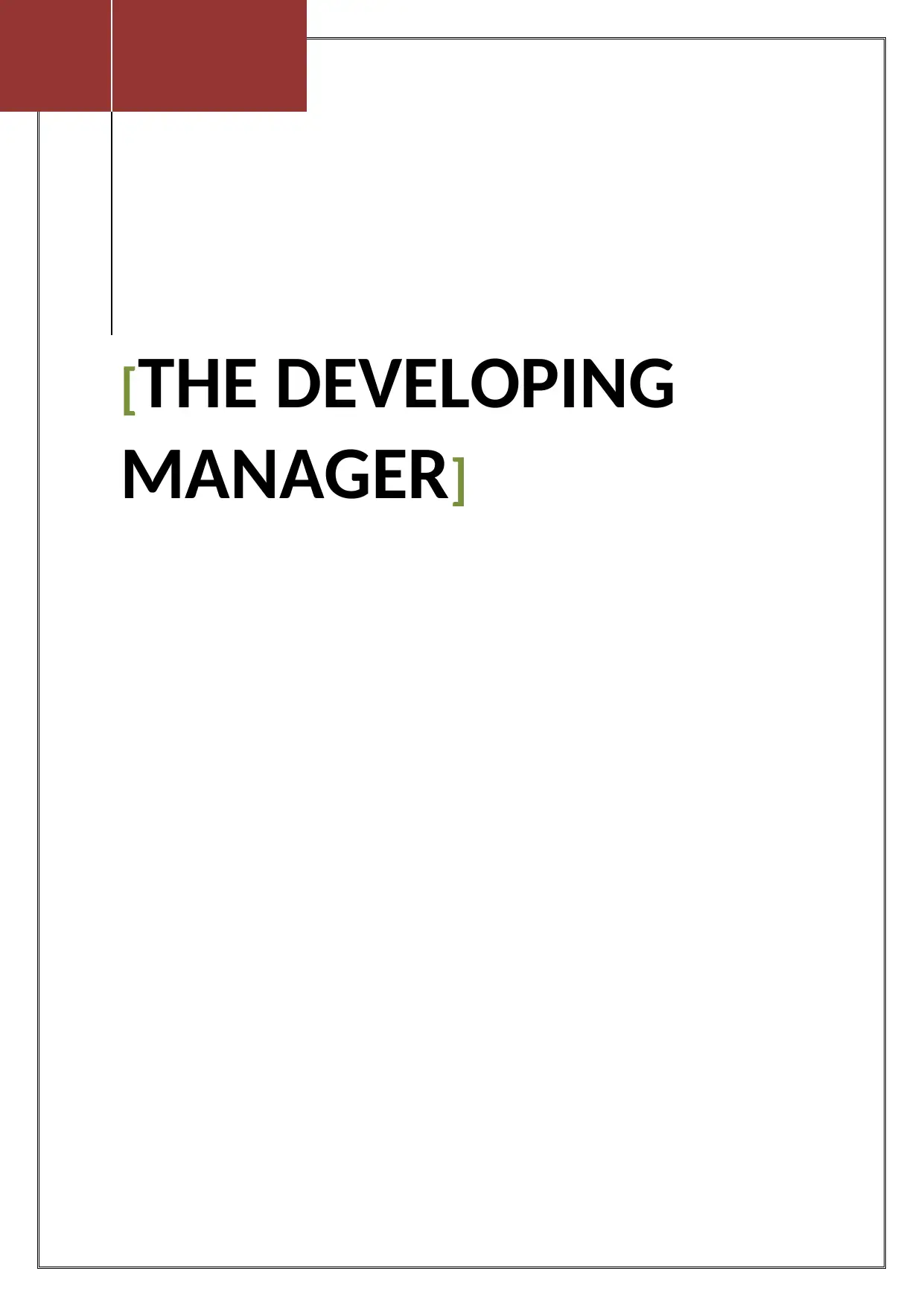
[THE DEVELOPING
MANAGER]
MANAGER]
Paraphrase This Document
Need a fresh take? Get an instant paraphrase of this document with our AI Paraphraser
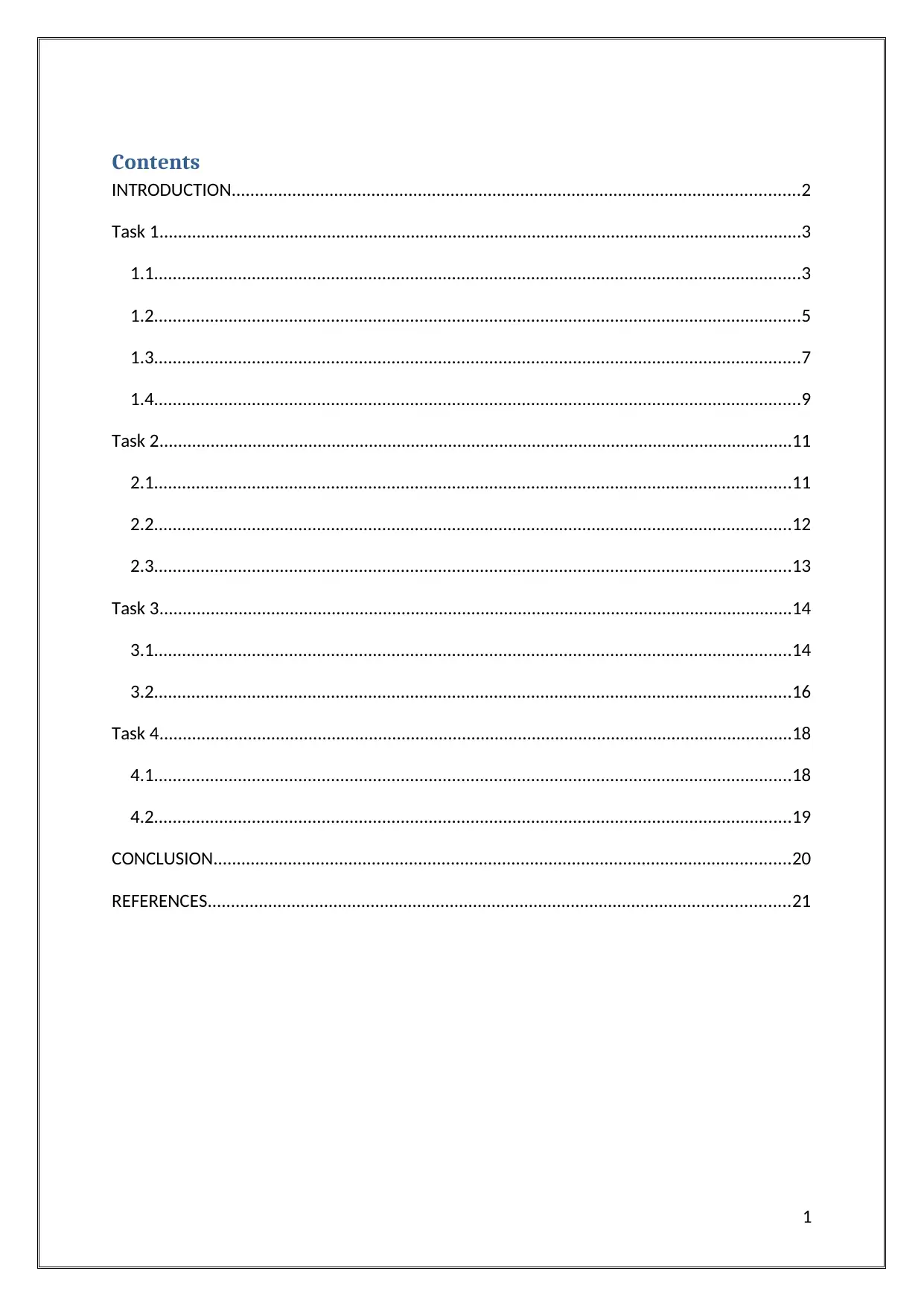
Contents
INTRODUCTION..........................................................................................................................2
Task 1..........................................................................................................................................3
1.1...........................................................................................................................................3
1.2...........................................................................................................................................5
1.3...........................................................................................................................................7
1.4...........................................................................................................................................9
Task 2........................................................................................................................................11
2.1.........................................................................................................................................11
2.2.........................................................................................................................................12
2.3.........................................................................................................................................13
Task 3........................................................................................................................................14
3.1.........................................................................................................................................14
3.2.........................................................................................................................................16
Task 4........................................................................................................................................18
4.1.........................................................................................................................................18
4.2.........................................................................................................................................19
CONCLUSION............................................................................................................................20
REFERENCES.............................................................................................................................21
1
INTRODUCTION..........................................................................................................................2
Task 1..........................................................................................................................................3
1.1...........................................................................................................................................3
1.2...........................................................................................................................................5
1.3...........................................................................................................................................7
1.4...........................................................................................................................................9
Task 2........................................................................................................................................11
2.1.........................................................................................................................................11
2.2.........................................................................................................................................12
2.3.........................................................................................................................................13
Task 3........................................................................................................................................14
3.1.........................................................................................................................................14
3.2.........................................................................................................................................16
Task 4........................................................................................................................................18
4.1.........................................................................................................................................18
4.2.........................................................................................................................................19
CONCLUSION............................................................................................................................20
REFERENCES.............................................................................................................................21
1
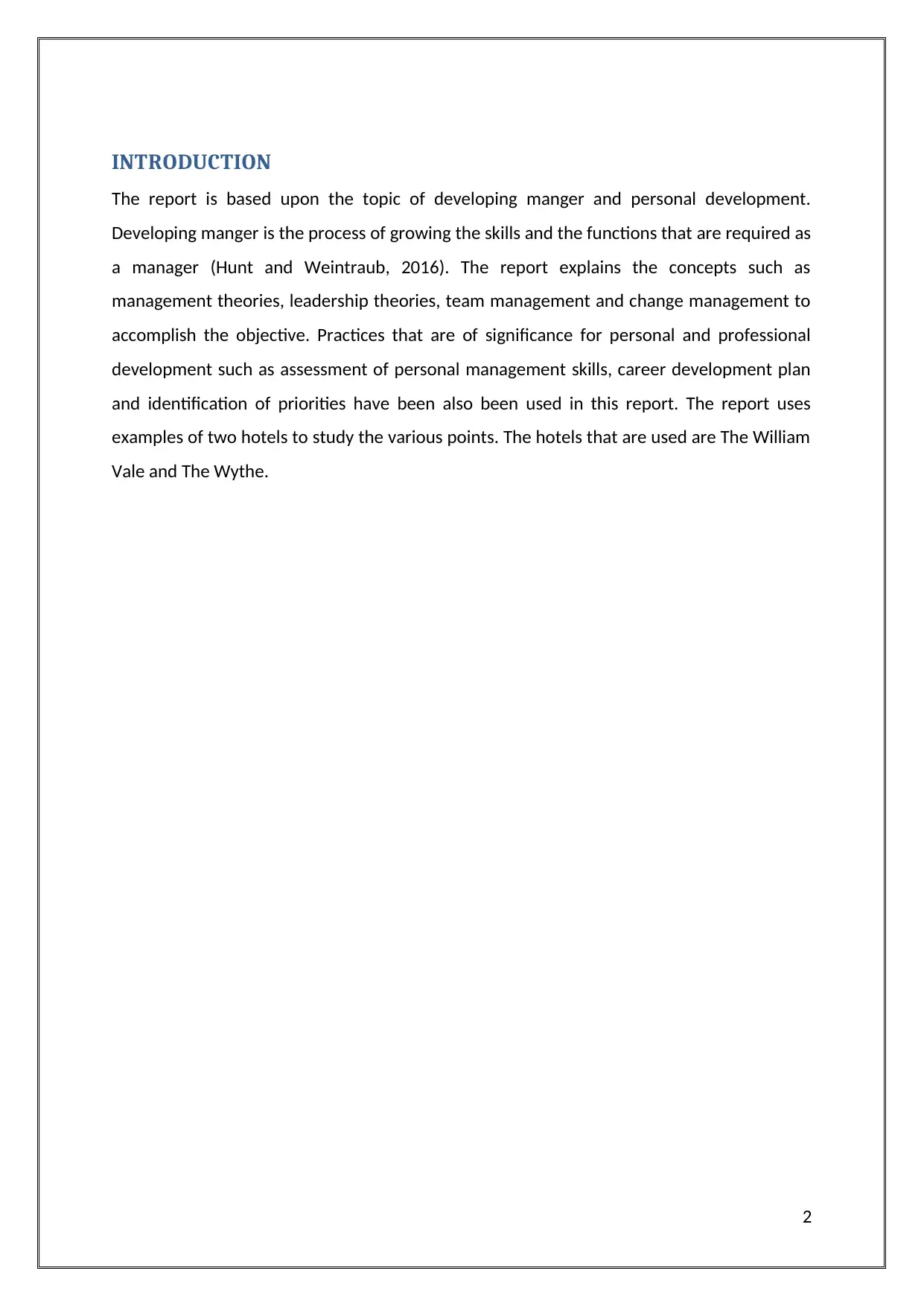
INTRODUCTION
The report is based upon the topic of developing manger and personal development.
Developing manger is the process of growing the skills and the functions that are required as
a manager (Hunt and Weintraub, 2016). The report explains the concepts such as
management theories, leadership theories, team management and change management to
accomplish the objective. Practices that are of significance for personal and professional
development such as assessment of personal management skills, career development plan
and identification of priorities have been also been used in this report. The report uses
examples of two hotels to study the various points. The hotels that are used are The William
Vale and The Wythe.
2
The report is based upon the topic of developing manger and personal development.
Developing manger is the process of growing the skills and the functions that are required as
a manager (Hunt and Weintraub, 2016). The report explains the concepts such as
management theories, leadership theories, team management and change management to
accomplish the objective. Practices that are of significance for personal and professional
development such as assessment of personal management skills, career development plan
and identification of priorities have been also been used in this report. The report uses
examples of two hotels to study the various points. The hotels that are used are The William
Vale and The Wythe.
2
⊘ This is a preview!⊘
Do you want full access?
Subscribe today to unlock all pages.

Trusted by 1+ million students worldwide
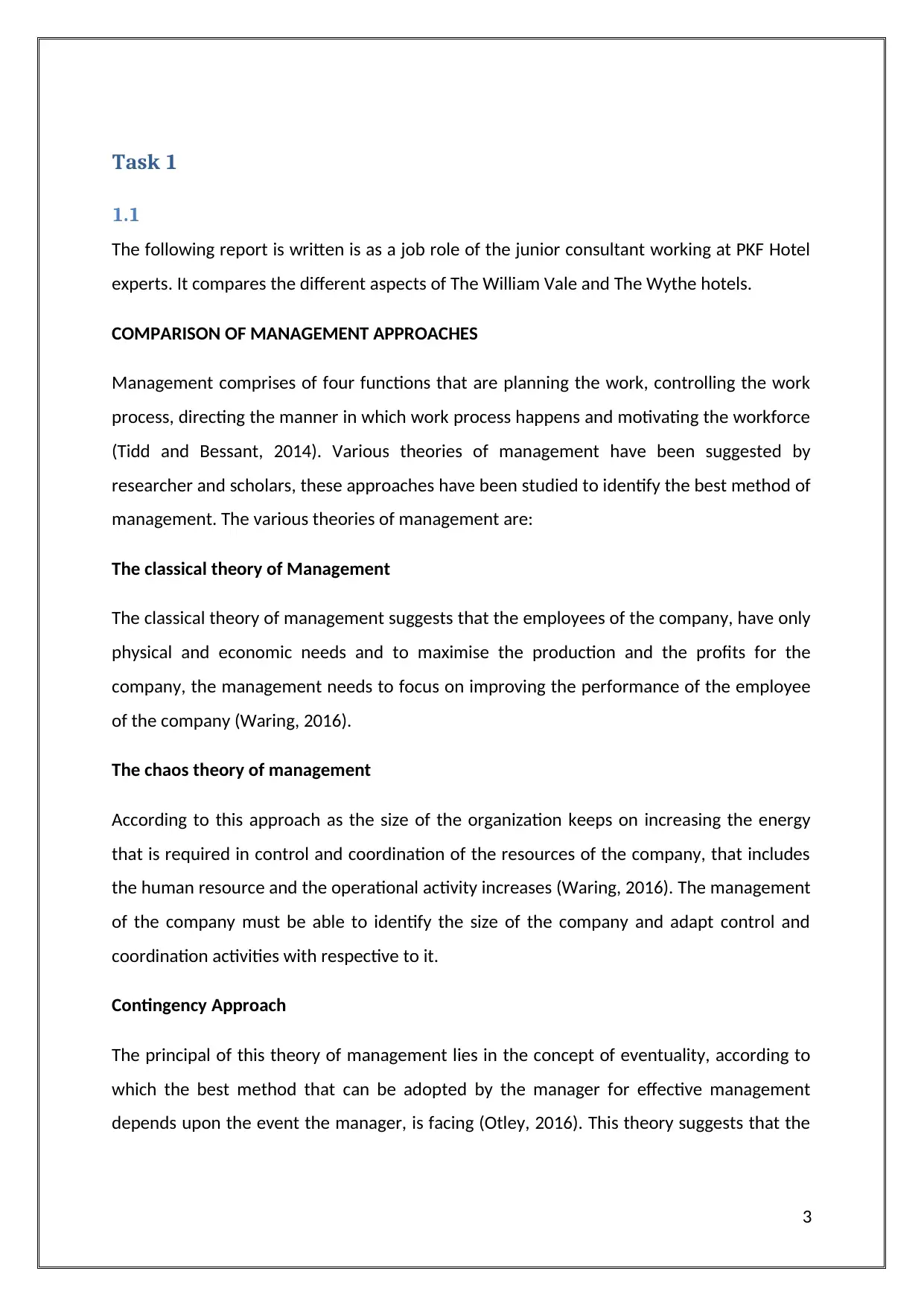
Task 1
1.1
The following report is written is as a job role of the junior consultant working at PKF Hotel
experts. It compares the different aspects of The William Vale and The Wythe hotels.
COMPARISON OF MANAGEMENT APPROACHES
Management comprises of four functions that are planning the work, controlling the work
process, directing the manner in which work process happens and motivating the workforce
(Tidd and Bessant, 2014). Various theories of management have been suggested by
researcher and scholars, these approaches have been studied to identify the best method of
management. The various theories of management are:
The classical theory of Management
The classical theory of management suggests that the employees of the company, have only
physical and economic needs and to maximise the production and the profits for the
company, the management needs to focus on improving the performance of the employee
of the company (Waring, 2016).
The chaos theory of management
According to this approach as the size of the organization keeps on increasing the energy
that is required in control and coordination of the resources of the company, that includes
the human resource and the operational activity increases (Waring, 2016). The management
of the company must be able to identify the size of the company and adapt control and
coordination activities with respective to it.
Contingency Approach
The principal of this theory of management lies in the concept of eventuality, according to
which the best method that can be adopted by the manager for effective management
depends upon the event the manager, is facing (Otley, 2016). This theory suggests that the
3
1.1
The following report is written is as a job role of the junior consultant working at PKF Hotel
experts. It compares the different aspects of The William Vale and The Wythe hotels.
COMPARISON OF MANAGEMENT APPROACHES
Management comprises of four functions that are planning the work, controlling the work
process, directing the manner in which work process happens and motivating the workforce
(Tidd and Bessant, 2014). Various theories of management have been suggested by
researcher and scholars, these approaches have been studied to identify the best method of
management. The various theories of management are:
The classical theory of Management
The classical theory of management suggests that the employees of the company, have only
physical and economic needs and to maximise the production and the profits for the
company, the management needs to focus on improving the performance of the employee
of the company (Waring, 2016).
The chaos theory of management
According to this approach as the size of the organization keeps on increasing the energy
that is required in control and coordination of the resources of the company, that includes
the human resource and the operational activity increases (Waring, 2016). The management
of the company must be able to identify the size of the company and adapt control and
coordination activities with respective to it.
Contingency Approach
The principal of this theory of management lies in the concept of eventuality, according to
which the best method that can be adopted by the manager for effective management
depends upon the event the manager, is facing (Otley, 2016). This theory suggests that the
3
Paraphrase This Document
Need a fresh take? Get an instant paraphrase of this document with our AI Paraphraser
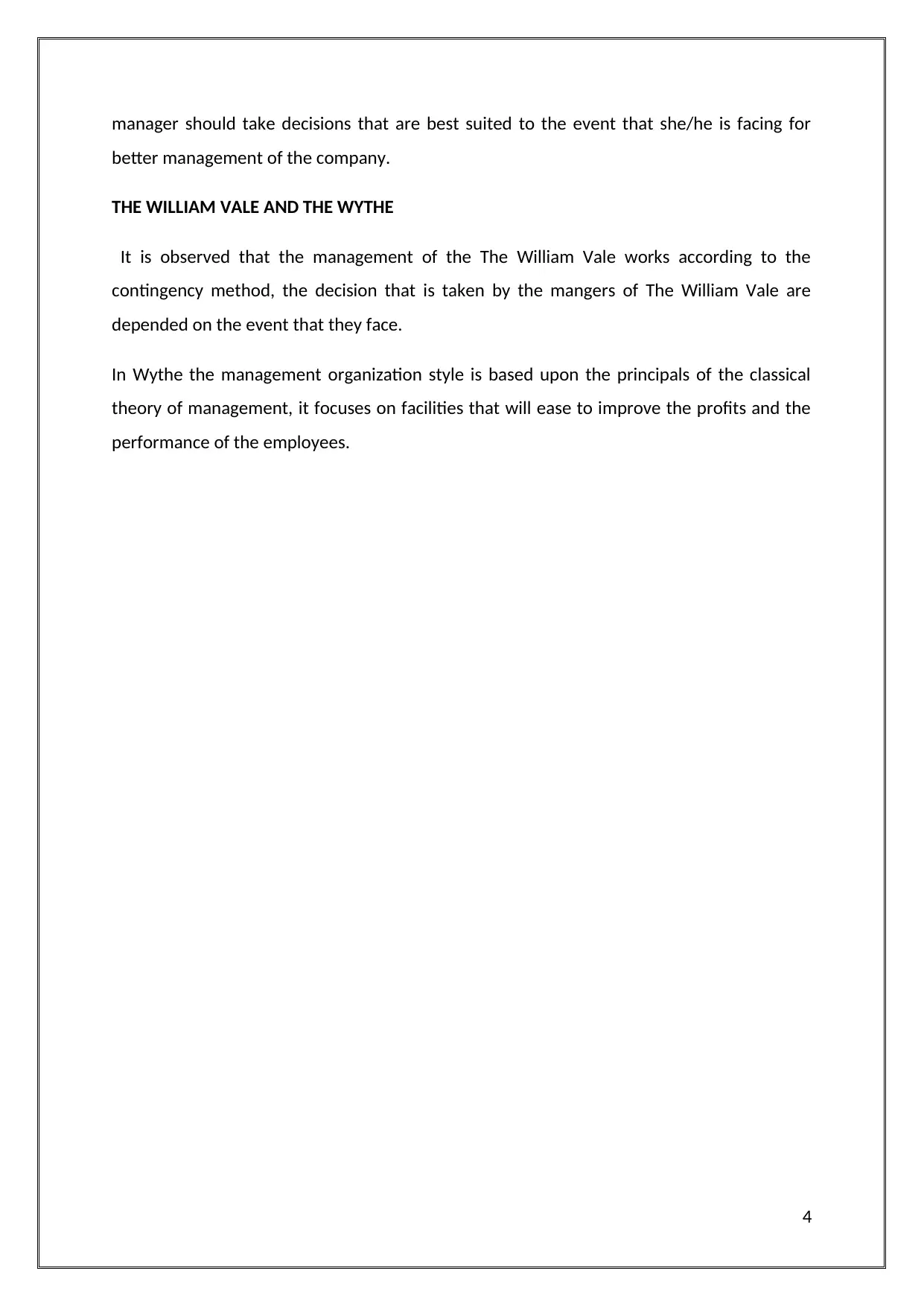
manager should take decisions that are best suited to the event that she/he is facing for
better management of the company.
THE WILLIAM VALE AND THE WYTHE
It is observed that the management of the The William Vale works according to the
contingency method, the decision that is taken by the mangers of The William Vale are
depended on the event that they face.
In Wythe the management organization style is based upon the principals of the classical
theory of management, it focuses on facilities that will ease to improve the profits and the
performance of the employees.
4
better management of the company.
THE WILLIAM VALE AND THE WYTHE
It is observed that the management of the The William Vale works according to the
contingency method, the decision that is taken by the mangers of The William Vale are
depended on the event that they face.
In Wythe the management organization style is based upon the principals of the classical
theory of management, it focuses on facilities that will ease to improve the profits and the
performance of the employees.
4
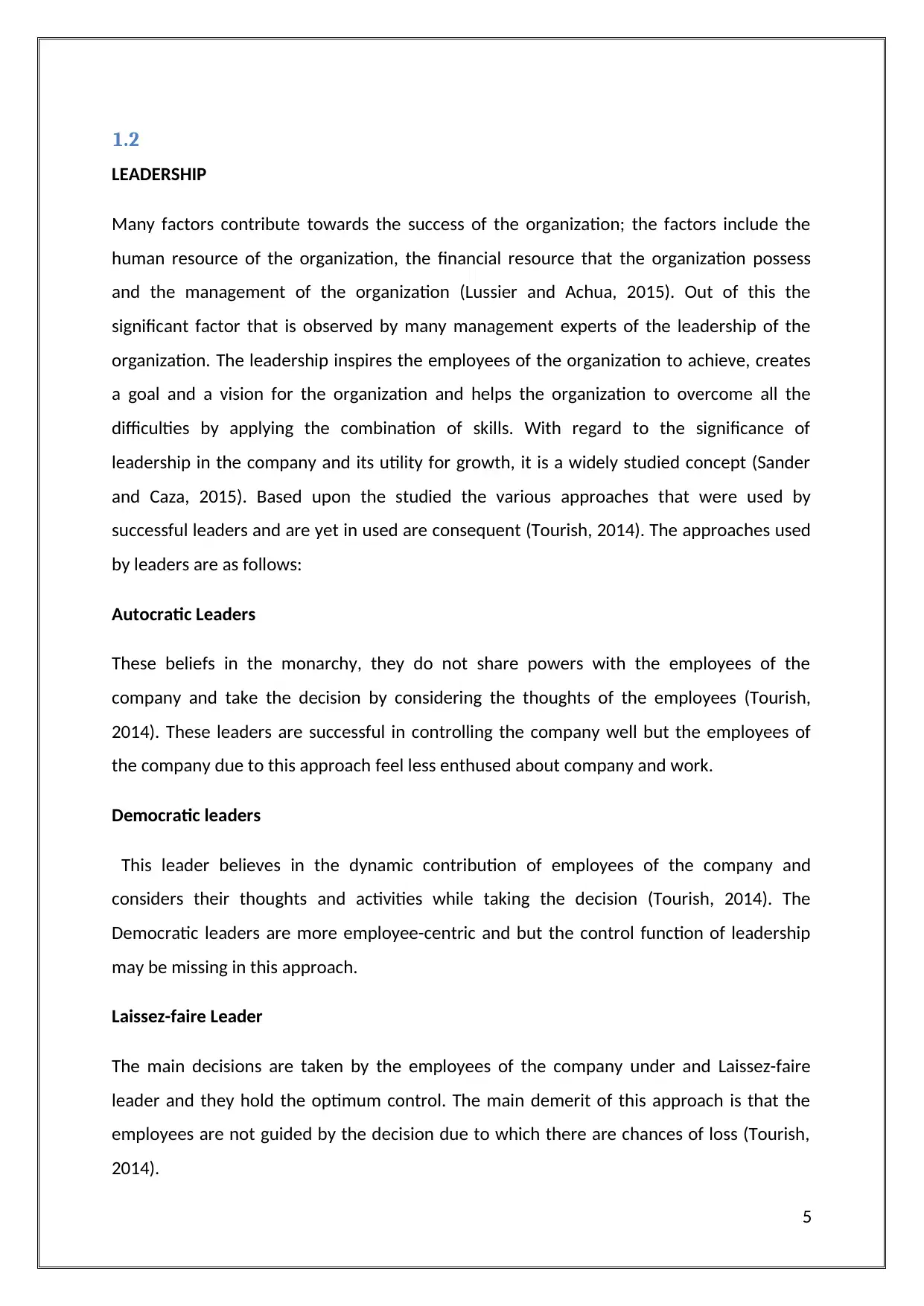
1.2
LEADERSHIP
Many factors contribute towards the success of the organization; the factors include the
human resource of the organization, the financial resource that the organization possess
and the management of the organization (Lussier and Achua, 2015). Out of this the
significant factor that is observed by many management experts of the leadership of the
organization. The leadership inspires the employees of the organization to achieve, creates
a goal and a vision for the organization and helps the organization to overcome all the
difficulties by applying the combination of skills. With regard to the significance of
leadership in the company and its utility for growth, it is a widely studied concept (Sander
and Caza, 2015). Based upon the studied the various approaches that were used by
successful leaders and are yet in used are consequent (Tourish, 2014). The approaches used
by leaders are as follows:
Autocratic Leaders
These beliefs in the monarchy, they do not share powers with the employees of the
company and take the decision by considering the thoughts of the employees (Tourish,
2014). These leaders are successful in controlling the company well but the employees of
the company due to this approach feel less enthused about company and work.
Democratic leaders
This leader believes in the dynamic contribution of employees of the company and
considers their thoughts and activities while taking the decision (Tourish, 2014). The
Democratic leaders are more employee-centric and but the control function of leadership
may be missing in this approach.
Laissez-faire Leader
The main decisions are taken by the employees of the company under and Laissez-faire
leader and they hold the optimum control. The main demerit of this approach is that the
employees are not guided by the decision due to which there are chances of loss (Tourish,
2014).
5
LEADERSHIP
Many factors contribute towards the success of the organization; the factors include the
human resource of the organization, the financial resource that the organization possess
and the management of the organization (Lussier and Achua, 2015). Out of this the
significant factor that is observed by many management experts of the leadership of the
organization. The leadership inspires the employees of the organization to achieve, creates
a goal and a vision for the organization and helps the organization to overcome all the
difficulties by applying the combination of skills. With regard to the significance of
leadership in the company and its utility for growth, it is a widely studied concept (Sander
and Caza, 2015). Based upon the studied the various approaches that were used by
successful leaders and are yet in used are consequent (Tourish, 2014). The approaches used
by leaders are as follows:
Autocratic Leaders
These beliefs in the monarchy, they do not share powers with the employees of the
company and take the decision by considering the thoughts of the employees (Tourish,
2014). These leaders are successful in controlling the company well but the employees of
the company due to this approach feel less enthused about company and work.
Democratic leaders
This leader believes in the dynamic contribution of employees of the company and
considers their thoughts and activities while taking the decision (Tourish, 2014). The
Democratic leaders are more employee-centric and but the control function of leadership
may be missing in this approach.
Laissez-faire Leader
The main decisions are taken by the employees of the company under and Laissez-faire
leader and they hold the optimum control. The main demerit of this approach is that the
employees are not guided by the decision due to which there are chances of loss (Tourish,
2014).
5
⊘ This is a preview!⊘
Do you want full access?
Subscribe today to unlock all pages.

Trusted by 1+ million students worldwide
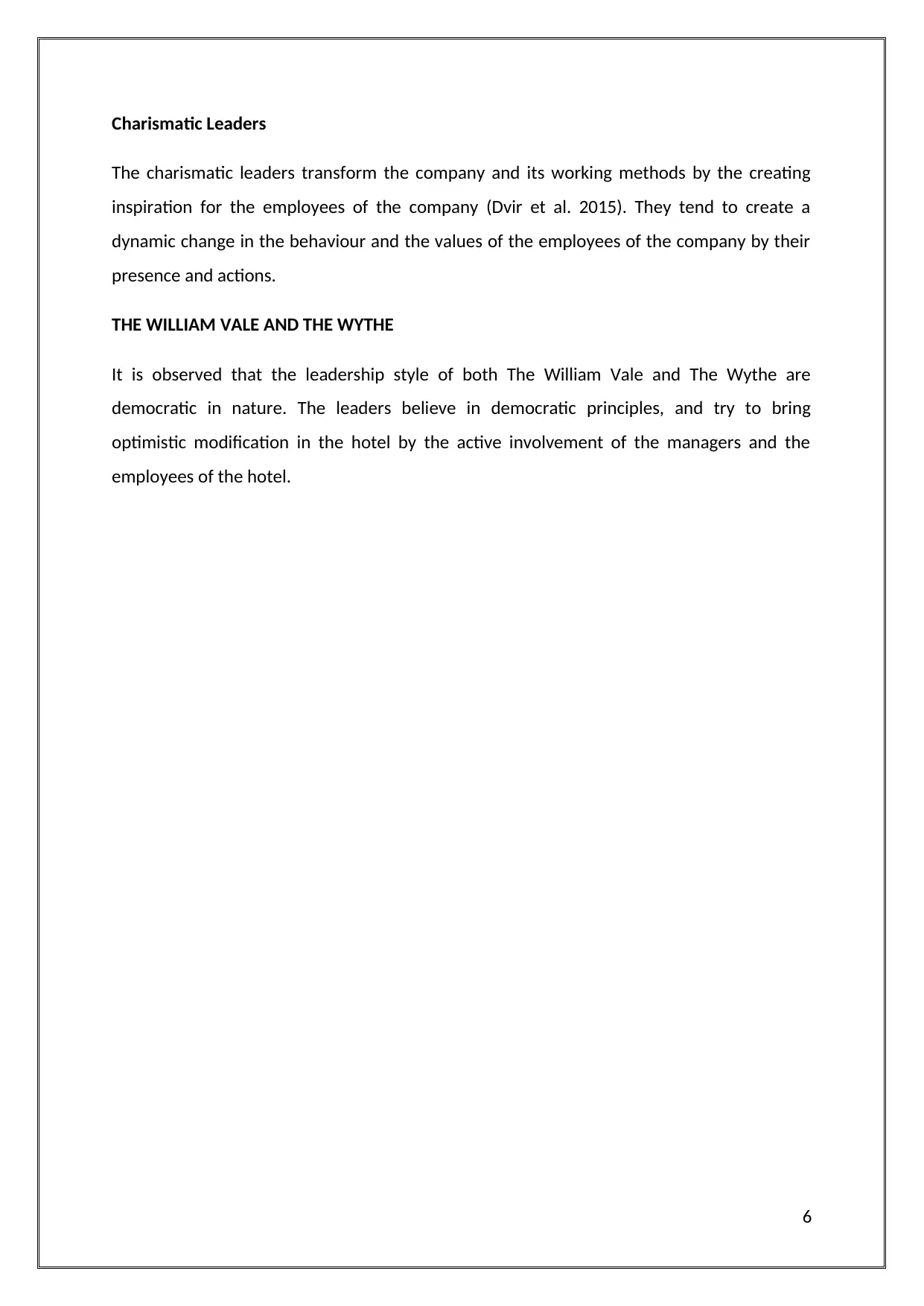
Charismatic Leaders
The charismatic leaders transform the company and its working methods by the creating
inspiration for the employees of the company (Dvir et al. 2015). They tend to create a
dynamic change in the behaviour and the values of the employees of the company by their
presence and actions.
THE WILLIAM VALE AND THE WYTHE
It is observed that the leadership style of both The William Vale and The Wythe are
democratic in nature. The leaders believe in democratic principles, and try to bring
optimistic modification in the hotel by the active involvement of the managers and the
employees of the hotel.
6
The charismatic leaders transform the company and its working methods by the creating
inspiration for the employees of the company (Dvir et al. 2015). They tend to create a
dynamic change in the behaviour and the values of the employees of the company by their
presence and actions.
THE WILLIAM VALE AND THE WYTHE
It is observed that the leadership style of both The William Vale and The Wythe are
democratic in nature. The leaders believe in democratic principles, and try to bring
optimistic modification in the hotel by the active involvement of the managers and the
employees of the hotel.
6
Paraphrase This Document
Need a fresh take? Get an instant paraphrase of this document with our AI Paraphraser
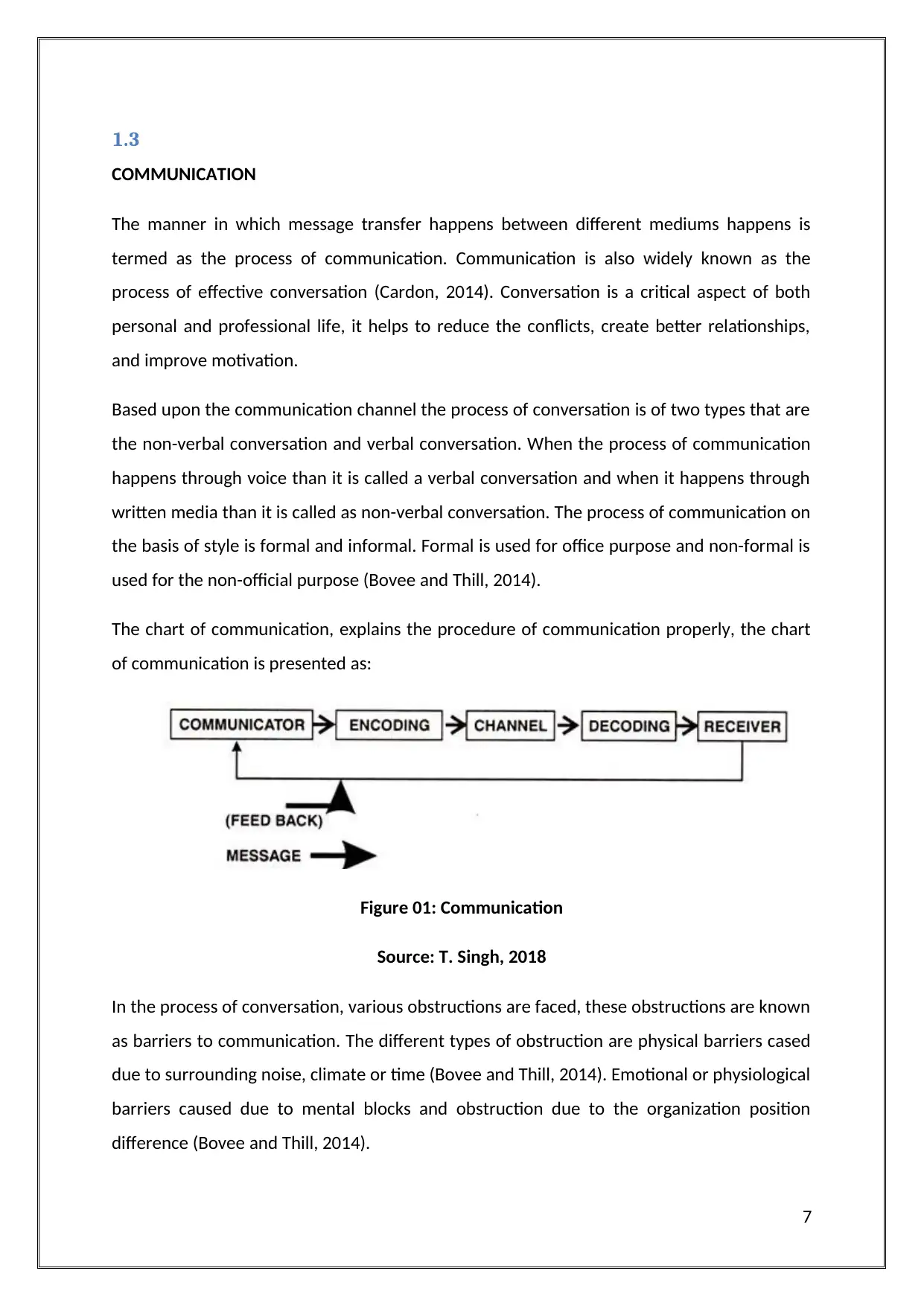
1.3
COMMUNICATION
The manner in which message transfer happens between different mediums happens is
termed as the process of communication. Communication is also widely known as the
process of effective conversation (Cardon, 2014). Conversation is a critical aspect of both
personal and professional life, it helps to reduce the conflicts, create better relationships,
and improve motivation.
Based upon the communication channel the process of conversation is of two types that are
the non-verbal conversation and verbal conversation. When the process of communication
happens through voice than it is called a verbal conversation and when it happens through
written media than it is called as non-verbal conversation. The process of communication on
the basis of style is formal and informal. Formal is used for office purpose and non-formal is
used for the non-official purpose (Bovee and Thill, 2014).
The chart of communication, explains the procedure of communication properly, the chart
of communication is presented as:
Figure 01: Communication
Source: T. Singh, 2018
In the process of conversation, various obstructions are faced, these obstructions are known
as barriers to communication. The different types of obstruction are physical barriers cased
due to surrounding noise, climate or time (Bovee and Thill, 2014). Emotional or physiological
barriers caused due to mental blocks and obstruction due to the organization position
difference (Bovee and Thill, 2014).
7
COMMUNICATION
The manner in which message transfer happens between different mediums happens is
termed as the process of communication. Communication is also widely known as the
process of effective conversation (Cardon, 2014). Conversation is a critical aspect of both
personal and professional life, it helps to reduce the conflicts, create better relationships,
and improve motivation.
Based upon the communication channel the process of conversation is of two types that are
the non-verbal conversation and verbal conversation. When the process of communication
happens through voice than it is called a verbal conversation and when it happens through
written media than it is called as non-verbal conversation. The process of communication on
the basis of style is formal and informal. Formal is used for office purpose and non-formal is
used for the non-official purpose (Bovee and Thill, 2014).
The chart of communication, explains the procedure of communication properly, the chart
of communication is presented as:
Figure 01: Communication
Source: T. Singh, 2018
In the process of conversation, various obstructions are faced, these obstructions are known
as barriers to communication. The different types of obstruction are physical barriers cased
due to surrounding noise, climate or time (Bovee and Thill, 2014). Emotional or physiological
barriers caused due to mental blocks and obstruction due to the organization position
difference (Bovee and Thill, 2014).
7
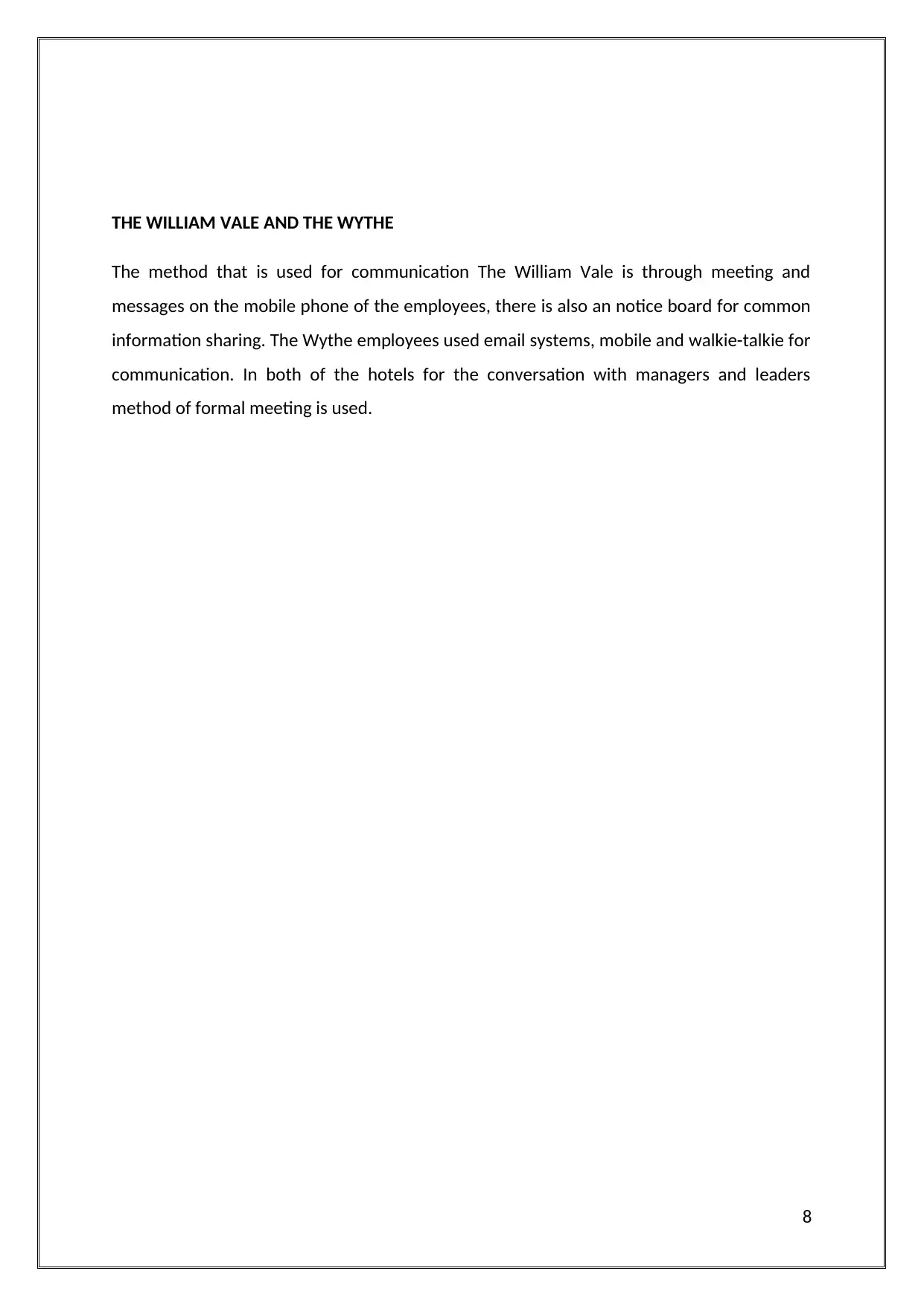
THE WILLIAM VALE AND THE WYTHE
The method that is used for communication The William Vale is through meeting and
messages on the mobile phone of the employees, there is also an notice board for common
information sharing. The Wythe employees used email systems, mobile and walkie-talkie for
communication. In both of the hotels for the conversation with managers and leaders
method of formal meeting is used.
8
The method that is used for communication The William Vale is through meeting and
messages on the mobile phone of the employees, there is also an notice board for common
information sharing. The Wythe employees used email systems, mobile and walkie-talkie for
communication. In both of the hotels for the conversation with managers and leaders
method of formal meeting is used.
8
⊘ This is a preview!⊘
Do you want full access?
Subscribe today to unlock all pages.

Trusted by 1+ million students worldwide
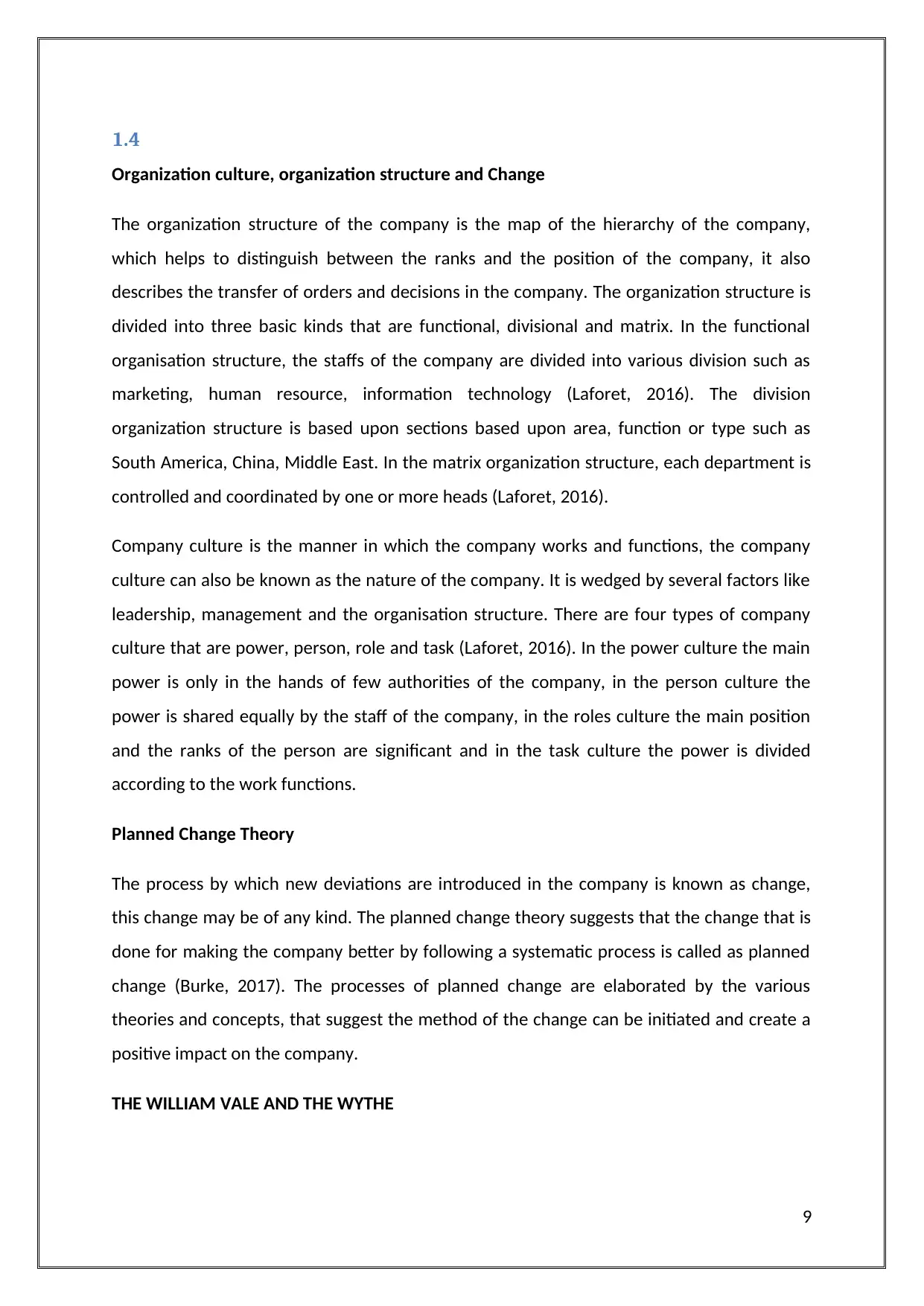
1.4
Organization culture, organization structure and Change
The organization structure of the company is the map of the hierarchy of the company,
which helps to distinguish between the ranks and the position of the company, it also
describes the transfer of orders and decisions in the company. The organization structure is
divided into three basic kinds that are functional, divisional and matrix. In the functional
organisation structure, the staffs of the company are divided into various division such as
marketing, human resource, information technology (Laforet, 2016). The division
organization structure is based upon sections based upon area, function or type such as
South America, China, Middle East. In the matrix organization structure, each department is
controlled and coordinated by one or more heads (Laforet, 2016).
Company culture is the manner in which the company works and functions, the company
culture can also be known as the nature of the company. It is wedged by several factors like
leadership, management and the organisation structure. There are four types of company
culture that are power, person, role and task (Laforet, 2016). In the power culture the main
power is only in the hands of few authorities of the company, in the person culture the
power is shared equally by the staff of the company, in the roles culture the main position
and the ranks of the person are significant and in the task culture the power is divided
according to the work functions.
Planned Change Theory
The process by which new deviations are introduced in the company is known as change,
this change may be of any kind. The planned change theory suggests that the change that is
done for making the company better by following a systematic process is called as planned
change (Burke, 2017). The processes of planned change are elaborated by the various
theories and concepts, that suggest the method of the change can be initiated and create a
positive impact on the company.
THE WILLIAM VALE AND THE WYTHE
9
Organization culture, organization structure and Change
The organization structure of the company is the map of the hierarchy of the company,
which helps to distinguish between the ranks and the position of the company, it also
describes the transfer of orders and decisions in the company. The organization structure is
divided into three basic kinds that are functional, divisional and matrix. In the functional
organisation structure, the staffs of the company are divided into various division such as
marketing, human resource, information technology (Laforet, 2016). The division
organization structure is based upon sections based upon area, function or type such as
South America, China, Middle East. In the matrix organization structure, each department is
controlled and coordinated by one or more heads (Laforet, 2016).
Company culture is the manner in which the company works and functions, the company
culture can also be known as the nature of the company. It is wedged by several factors like
leadership, management and the organisation structure. There are four types of company
culture that are power, person, role and task (Laforet, 2016). In the power culture the main
power is only in the hands of few authorities of the company, in the person culture the
power is shared equally by the staff of the company, in the roles culture the main position
and the ranks of the person are significant and in the task culture the power is divided
according to the work functions.
Planned Change Theory
The process by which new deviations are introduced in the company is known as change,
this change may be of any kind. The planned change theory suggests that the change that is
done for making the company better by following a systematic process is called as planned
change (Burke, 2017). The processes of planned change are elaborated by the various
theories and concepts, that suggest the method of the change can be initiated and create a
positive impact on the company.
THE WILLIAM VALE AND THE WYTHE
9
Paraphrase This Document
Need a fresh take? Get an instant paraphrase of this document with our AI Paraphraser
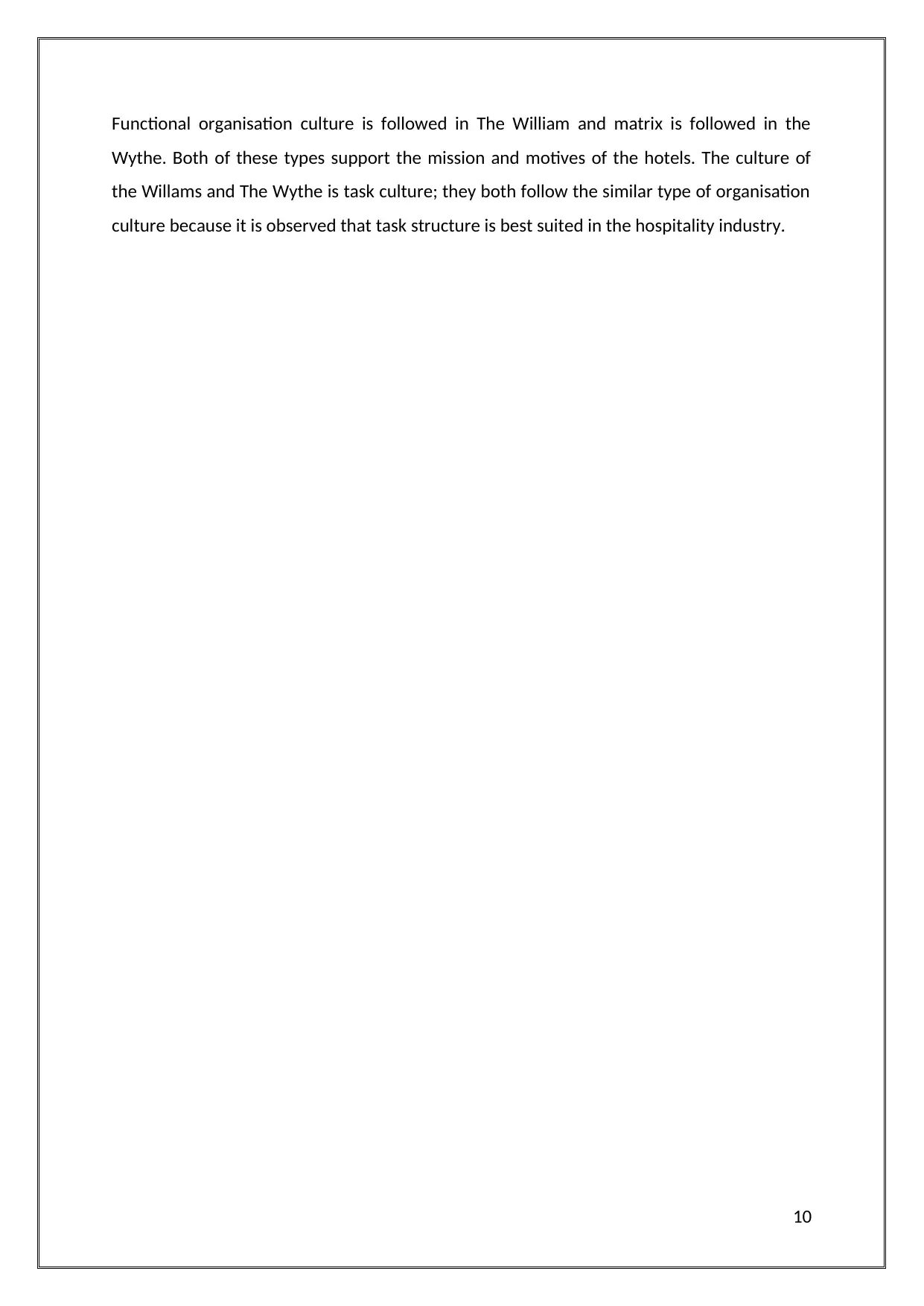
Functional organisation culture is followed in The William and matrix is followed in the
Wythe. Both of these types support the mission and motives of the hotels. The culture of
the Willams and The Wythe is task culture; they both follow the similar type of organisation
culture because it is observed that task structure is best suited in the hospitality industry.
10
Wythe. Both of these types support the mission and motives of the hotels. The culture of
the Willams and The Wythe is task culture; they both follow the similar type of organisation
culture because it is observed that task structure is best suited in the hospitality industry.
10
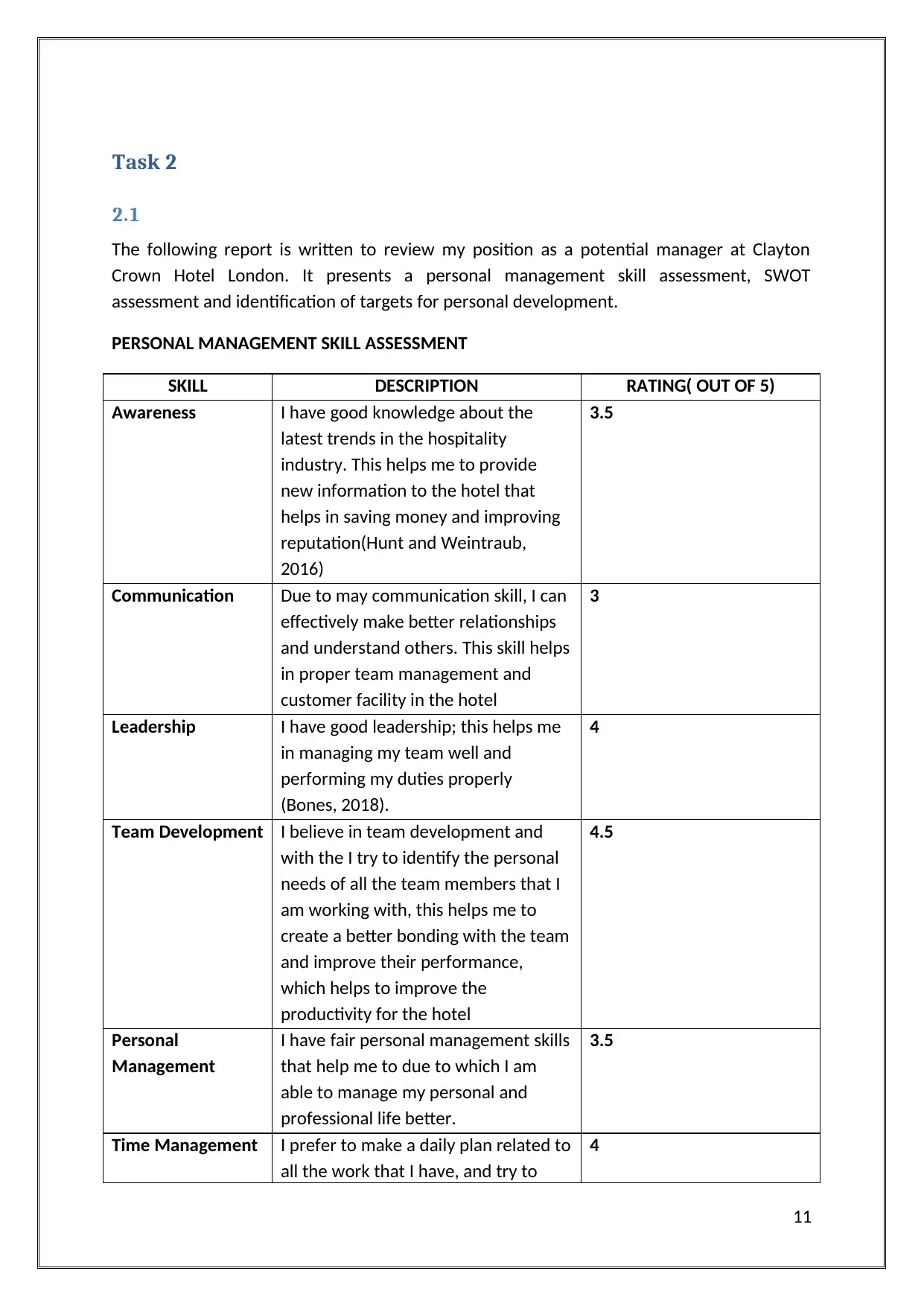
Task 2
2.1
The following report is written to review my position as a potential manager at Clayton
Crown Hotel London. It presents a personal management skill assessment, SWOT
assessment and identification of targets for personal development.
PERSONAL MANAGEMENT SKILL ASSESSMENT
SKILL DESCRIPTION RATING( OUT OF 5)
Awareness I have good knowledge about the
latest trends in the hospitality
industry. This helps me to provide
new information to the hotel that
helps in saving money and improving
reputation(Hunt and Weintraub,
2016)
3.5
Communication Due to may communication skill, I can
effectively make better relationships
and understand others. This skill helps
in proper team management and
customer facility in the hotel
3
Leadership I have good leadership; this helps me
in managing my team well and
performing my duties properly
(Bones, 2018).
4
Team Development I believe in team development and
with the I try to identify the personal
needs of all the team members that I
am working with, this helps me to
create a better bonding with the team
and improve their performance,
which helps to improve the
productivity for the hotel
4.5
Personal
Management
I have fair personal management skills
that help me to due to which I am
able to manage my personal and
professional life better.
3.5
Time Management I prefer to make a daily plan related to
all the work that I have, and try to
4
11
2.1
The following report is written to review my position as a potential manager at Clayton
Crown Hotel London. It presents a personal management skill assessment, SWOT
assessment and identification of targets for personal development.
PERSONAL MANAGEMENT SKILL ASSESSMENT
SKILL DESCRIPTION RATING( OUT OF 5)
Awareness I have good knowledge about the
latest trends in the hospitality
industry. This helps me to provide
new information to the hotel that
helps in saving money and improving
reputation(Hunt and Weintraub,
2016)
3.5
Communication Due to may communication skill, I can
effectively make better relationships
and understand others. This skill helps
in proper team management and
customer facility in the hotel
3
Leadership I have good leadership; this helps me
in managing my team well and
performing my duties properly
(Bones, 2018).
4
Team Development I believe in team development and
with the I try to identify the personal
needs of all the team members that I
am working with, this helps me to
create a better bonding with the team
and improve their performance,
which helps to improve the
productivity for the hotel
4.5
Personal
Management
I have fair personal management skills
that help me to due to which I am
able to manage my personal and
professional life better.
3.5
Time Management I prefer to make a daily plan related to
all the work that I have, and try to
4
11
⊘ This is a preview!⊘
Do you want full access?
Subscribe today to unlock all pages.

Trusted by 1+ million students worldwide
1 out of 24
Related Documents
Your All-in-One AI-Powered Toolkit for Academic Success.
+13062052269
info@desklib.com
Available 24*7 on WhatsApp / Email
![[object Object]](/_next/static/media/star-bottom.7253800d.svg)
Unlock your academic potential
Copyright © 2020–2025 A2Z Services. All Rights Reserved. Developed and managed by ZUCOL.





